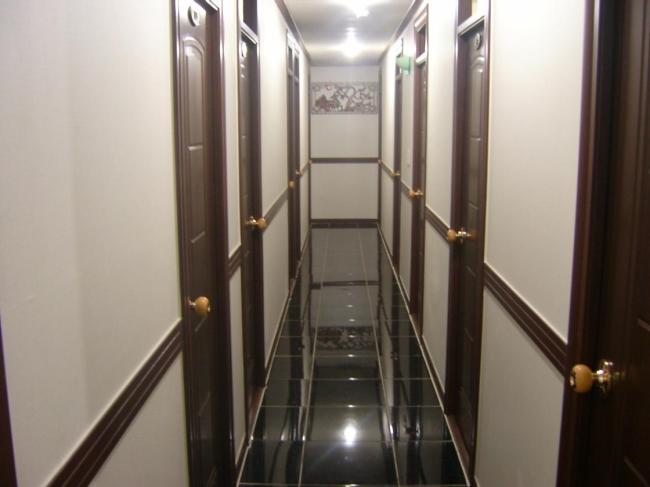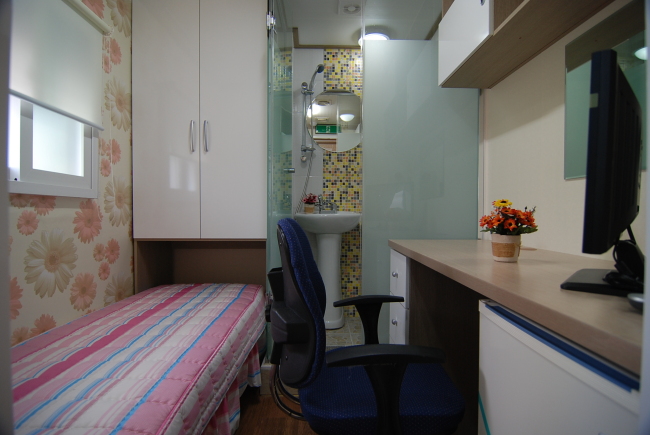In terms of uniquely Korean housing culture, one can’t leave out the humblest abode: the “gosiwon,” a low-cost, sparsely furnished, month-to-month rental room that does not require a deposit.

The hallway of a typical gosiwon (jointroom.com)

A typical gosiwon room, with basic furniture squeezed into about 4 square meters (gosiwonhome.com)
A gosiwon, a residential room as tiny as 3.5 square meters, is furnished with a desk, bookshelf and bed. The business originally took off to temporarily accommodate young tenants studying for state examinations ― hence its name, a portmanteau of “goshi,” the state examination for students seeking to become public servants and legal practitioners, and “won,” a lodging or institution.
The popularity of gosiwon as a living space has grown rapidly in the office-packed areas of Seoul. Now there are “gositels,” a combination of gosiwon and hotels.
“I moved to a gosiwon to concentrate on the National Civil Service Examination,” said a 33-year-old surnamed Kim, who is married with one child. Kim left his wife at home and began living alone in a gosiwon in Namyeong-dong, central Seoul, two metro stops away from his preparatory academy for prospective civil servants.
“Technically you have access to everything for minimal living, such as Internet access, a television and a fridge,” he said.
The housing market for gosiwon has grown popular over the past few years, even as the government announced plans to downsize the number of civil servants in 2008, on top of the termination of the state bar exam by 2017.
From 2010 to 2014, the number of gosiwon almost doubled from 6,597 to 11,457, according to statistics by the state-run National Emergency Management Agency.
About 78 percent of these gosiwon were located in Seoul and Gyeonggi Province in 2014, mostly due to growing demand by job seekers as an affordable housing alternative.
Yoon Ji-soo, a 25-year-old college graduate from Gyeonggi Province, said she considered a gosiwon after she got a job offer from a well-paying company in Seoul.
“They wanted me to begin work right away, so I did not have enough time to seek contracts through real estate brokers,” she said.
Yoon looked to nearby gosiwon because they offer a flexible length of stay, and above all, they do not require a deposit.
“But I do think gosiwon have their shortcomings too, such as poorly soundproofed walls and having to share the kitchen with strangers.”
To meet the changing demand, some gosiwon target specific groups of tenants for higher rents.
“Many of our tenants are students who take foreign language lessons in hagwon (private learning institutions),” said a manager of a gosiwon in Jongno, central Seoul, a mecca for private foreign language schools.
The monthly rent is 600,000 won ($550) with a private bathroom, considerably higher than the average 400,000 won range.
“Our gosiwon is a perfect fit for students because they can organize study groups among gosiwon mates, and their hagwon is only a couple minutes’ walk,” the manager said.
Some gosiwon target single, white-collar workers.
“Many of our guests include Samsung employees whose offices are only blocks away,” said a manager of a gosiwon near City Hall Station.
She offered monthly rents of 500,000 won and up, citing a “superior security system and tenants with decent social standing.”
Some gosiwon in the upscale Cheongdam-dong, southern Seoul, take advantage of the affluent “Cheongdam brand power.”
“It is only a five-minute walk from Cheongdam Station, and the rent is 430,000 won for a room with a private restroom and 330,000 won without,” said a manager of a gosiwon in Cheongdam-dong.
The gosiwon advertises that it is a five-minute walk from Galleria Department Store and a supermarket chain, and is close to Cheongdam Park and Bongeunsa Buddhist Temple. The facilities, however, are no more luxurious than gosiwon in other areas.
The increasing supply of gosiwon as alternative housing is expected to continue in the outskirts of Seoul as well.
According to Seoul City data, the number of gosiwon in Dobong, Geumcheon, Jungnang, Gangbuk and Seongbuk districts jumped 50 percent in 2013 over four years, even though the regions lacked large office headquarters, colleges and hagwon.
By Chung Joo-won (joowonc@heraldcorp.com)





![[KH Explains] No more 'Michael' at Kakao Games](http://res.heraldm.com/phpwas/restmb_idxmake.php?idx=645&simg=/content/image/2024/04/28/20240428050183_0.jpg&u=20240428180321)

